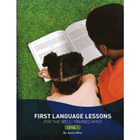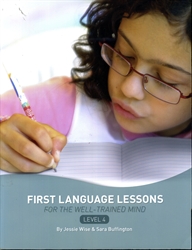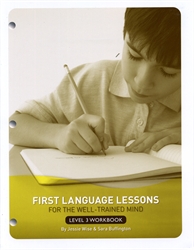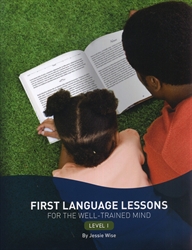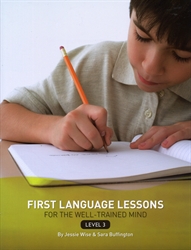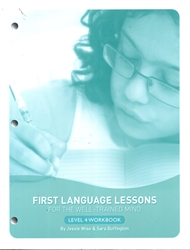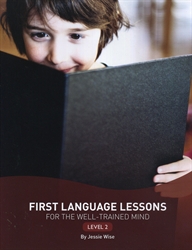Jessie Wise, co-author of The Well-Trained Mind, has written First Language Lessons (FLL), a series of four courses for grades one through four that supports classical education as described in The Well-Trained Mind. FLL actually combines Charlotte Mason’s ideas and classical education elements.
FLL mimics many elements of resources such as English for the Thoughtful Child by Mary Hyde and Cyndi Shearer and Emma Serl’s Primary Language Arts and Intermediate Language Arts, all of which have been popular among Charlotte Mason advocates. Common to all are the use of art reproductions as prompts for discussion, narration, and writing. Picture studies are intermixed with poems, fables, and other short writings. Also common to all of these resources is the presentation of questions for parents or teachers to use to guide the instruction that covers the broad range of language arts including reading and listening comprehension, grammar, oral expression, and composition.
However, FLL adds a much stronger emphasis on recitation, repetition, and memorization. This represents the “Dorothy Sayers” line of thought in classical education that young children in the first (or grammar) stage of learning should be learning in this way.
There is much more content in FLL books than in English for the Thoughtful Child or Emma Serl's books. FLL has 100 lessons each for Levels 1 and 2, 89 in Level 3, and 85 in Level 4. In FLL, grammar rules, usage, writing skills, listening and reading comprehension, and proper oral usage are all covered using four techniques: memory work, copying and dictation, narration, and grammar lessons.
Lessons follow a developmental sequence. For example, students do a minimal amount of copying for the first half of Level 1. They might copy their own name or a short list of pronouns. They continue with increasingly difficult copywork until Level 2 when they begin taking dictation.
Let’s look at each of the techniques used by this program. Children memorize poems, rules, definitions, and short lists. Poetry memorization helps children develop a familiarity with the rhythm and style of good language. Memorization of rules, definitions, and lists helps children acquire the “grammar” of English language.
Copying develops writing skills plus familiarity with spelling and proper usage. As Jessie Wise says, “Copywork engages both the visual and motor memory of the student. It gives the student models of properly constructed sentences” (Level 4, p. 1). After students have developed sufficient fluency in handwriting, spelling, and mechanics, they can begin taking dictation which is introduced in Level 2, lesson 22. Dictation exercises are never longer than a sentence for this level.
Narration practice prepares children for their own original writing. The parent reads a short fable or story to his or her child, or the child examines a piece of art reproduced in the book. Then the child relates key elements of the story or picture. Parents can use the scripted questions to help their children recall or elicit elements of the story or artwork. Artwork is often used as a springboard to grammar. For example, one piece is used to discuss prepositions and placement of objects in the picture.
The largest amount of attention seems dedicated to grammar lessons. These are scripted dialogues that call for repetition of rules and oral responses. Sometimes children are prompted to come up with their own examples for categories such as proper and common nouns.
Repetition is used much more than in other programs. For example, the third lesson on pronouns (Level 1, lesson 48) begins with recitation of the definition of a pronoun three times. Then the lesson continues with children continually repeating lists or sentences through the end of the lesson. I imagine you could take the lesson idea and use your own style of presentation if this sounds as boring to you as it does to me. (While the repetition seems excessive to me, I don’t think it’s as overdone as it is in Shurley Grammar.)
Grammar coverage focuses heavily upon parts of speech, covering all eight by the end of Level 2. First Language Lessons covers all of the other elements of grammar such as sentence formation, capitalization, punctuation, plurals, suffixes, contractions, and usage. Diagramming is introduced in Level 3. While much of this is taught explicitly, when children are copying and taking dictation, they learn much of it from the models and usage.
Children are not required to do much writing in the first two levels, but there are occasional enrichment activities for those able to do more than is required. Some of these include hands-on activities that I think would really appeal to all children. For example, one enrichment activity has a child use his body, furniture, toys, and a box to “act out” prepositions.
More writing is required in Levels 3 and 4. Because of this, Levels 3 and 4 each have a separate student workbook with 345 and 380 pages, respectively. Large fonts and plenty of white space make the individual pages very manageable for children; these workbooks are not intimidating despite their size. The workbooks cannot be used on their own. They are adjuncts to lessons taught from the instructor’s book.
The Level 1 and 2 books and Level 3 and 4 instruction books are non-consumable. For the first two levels, children should maintain a separate binder where they keep all of their work.
All of the books are available in either print or downloadable PDF versions.
An optional First Language Lessons Audio Companion might appeal to some families. Seventy-five minutes of recorded material on 48 tracks accompany the lessons in the first two FLL levels. Professionally produced, the recording includes dramatized readings by radio “actor” Mark Russo and sing-along songs by Mike Smith. The FLL Audio Companion is available on CD or by MP3 download.
I know that some parents greatly appreciate the detailed lesson presentation, the script that tells them what to say, when to have children repeat things, etc. Other parents will find this approach much too structured and controlled. The elements that make it so structured (i.e., memorization of parts of speech, excessive repetition) almost overwhelm the elements reflecting Charlotte Mason’s ideas. In my opinion, more narration activity and free flowing discussion would better reflect Mason’s philosophy, but those looking for a Dorothy Sayers style of classical education should find this a good fit.

